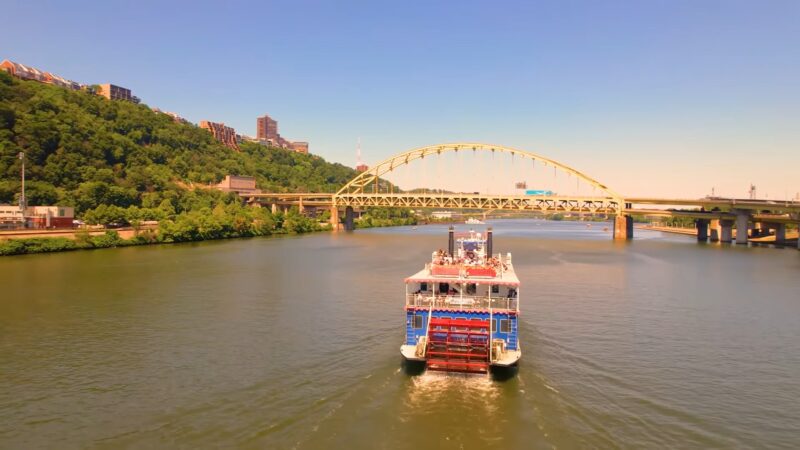Nestled at the confluence of three mighty rivers, Pittsburgh stands as a testament to human ingenuity and architectural prowess. Often dubbed the “City of Bridges,” Pittsburgh’s skyline is punctuated by these iconic structures, each narrating a tale of history, resilience, and progress.
As vital arteries connecting the city’s fragmented landscape, these bridges are more than mere passageways; they are emblematic of Pittsburgh’s rich tapestry of culture, commerce, and community.
City’s Vibrant History

Pittsburgh’s history is deeply intertwined with its bridges, 446 of them to be precise. As the city transitioned from a frontier settlement to an industrial powerhouse, the rivers that carved its landscape became both barriers and gateways.
The early bridges of Pittsburgh were rudimentary wooden structures, often prone to the whims of nature. Fires, floods, and the wear and tear of time took their toll. With the advent of the steel industry, for which Pittsburgh was renowned, the city saw a revolution in bridge construction.
Steel bridges, sturdier and more durable than their wooden predecessors, began to dot the cityscape. These new structures not only facilitated the movement of goods and people but also became symbols of Pittsburgh’s industrial strength and engineering innovation.
The Three Rivers
Pittsburgh, often referred to as the “City of Bridges,” owes much of its unique character and historical significance to the confluence of its three iconic rivers: the Allegheny, Monongahela, and Ohio.
These waterways have been the lifeblood of the city, shaping its topography, influencing its economic growth, and carving a distinctive cultural and historical landscape.
Their convergence at Pittsburgh’s heart, known as the Point, has made the city a strategic nexus of transportation and trade, while also bestowing it with unparalleled scenic beauty.
The Allegheny River

Originating from the verdant hills of northern Pennsylvania, the Allegheny River flows southward, meandering through lush landscapes before meeting the Monongahela in Pittsburgh. Historically, the Allegheny played a pivotal role in the region’s trade and transportation, with its waters bearing coal, timber, and other goods.
Its banks have witnessed the rise and fall of industries, the evolution of communities, and the ever-changing tapestry of Pittsburgh’s northern neighborhoods. Today, the river is not just a testament to the city’s industrious past but also a hub for recreation, with its shores dotted with parks, trails, and vibrant urban spaces.
The Monongahela River
The Monongahela River, affectionately known as the “Mon,” has its roots in West Virginia, flowing northward to embrace Pittsburgh. The Monongahela was a crucial waterway for the transportation of coal, supporting the burgeoning steel industry that would define Pittsburgh’s identity.
The river has seen the rise of steel mills along its banks, echoing with the clang of industry and the aspirations of generations. While the mills have since given way to modern developments, the Monongahela stands as a reminder of Pittsburgh’s resilient spirit, its waters reflecting the city’s rich history and promising future.
The Ohio River
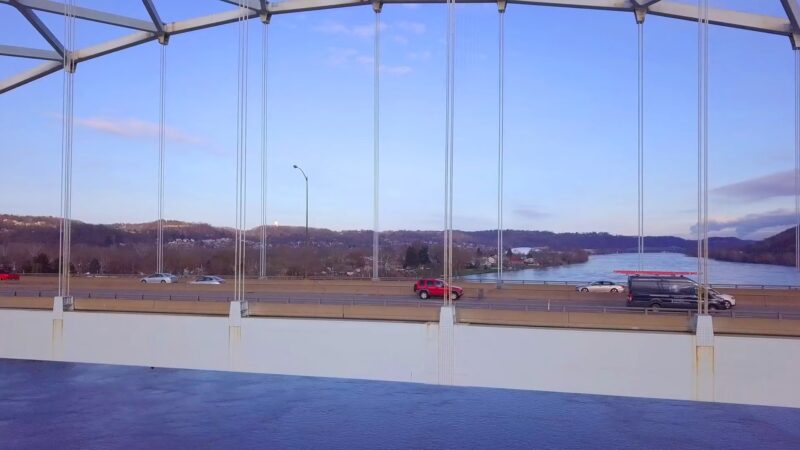
Born from the union of the Allegheny and Monongahela rivers, the Ohio River charts its course westward, serving as a vital waterway that has shaped much of America’s inland trade. The Ohio’s significance to Pittsburgh cannot be overstated.
It has been a gateway to the west, facilitating the movement of people and goods and playing a central role in the city’s economic and cultural evolution. The riverbanks, once bustling with docks and warehouses, now offer a blend of historical sites and recreational spaces, making the Ohio River a confluence of Pittsburgh’s past, present, and future.
Famous Bridges of Pittsburgh
These structures, standing as testaments to engineering prowess and historical significance, have shaped the city’s skyline and its cultural identity. Their presence not only facilitates connectivity but also weaves a narrative of resilience, innovation, and progress.
| Name | Date Built | River Spanned | Type | Notable Features |
|---|---|---|---|---|
| Roberto Clemente Bridge | 1928 | Allegheny River | Suspension | Painted in a golden hue; pedestrian-friendly; proximity to PNC Park. |
| Andy Warhol Bridge | 1926 | Allegheny River | Suspension | Named after the iconic artist; often features art installations. |
| Smithfield Street Bridge | 1883 | Monongahela River | Lenticular truss | One of the oldest steel bridges in the U.S.; National Historic Landmark. |
| Fort Pitt Bridge | 1959 | Monongahela River | Cantilevered arch | Offers a panoramic entrance to the city’s downtown; featured in many films. |
| 16th Street Bridge | 1923 | Allegheny River | Through arch bridge | Neo-Gothic design elements; connects the Strip District to the North Shore. |
Engineering and Architectural Marvels
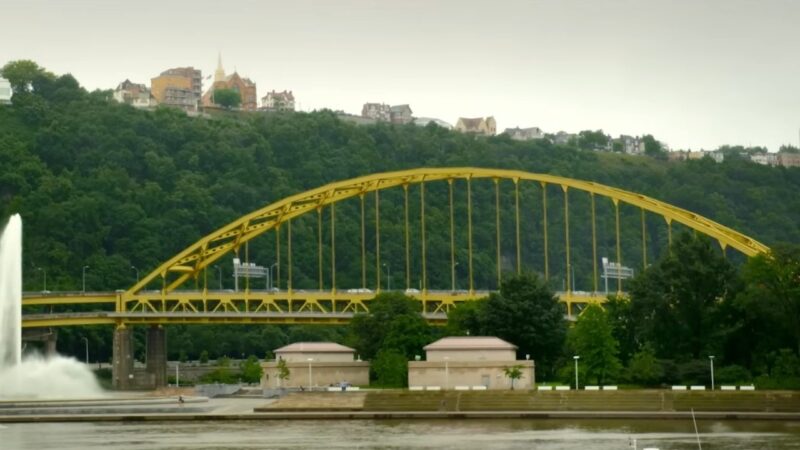
The bridges of Pittsburgh are a confluence of art and science. The city’s undulating landscape, with its steep ravines and expansive rivers, posed formidable challenges to bridge builders. Traditional designs had to be reimagined, leading to engineering marvels.
The use of cantilevers in some bridges showcased the innovative spirit of Pittsburgh’s engineers. The city’s bridges also encompass a diverse range of architectural styles.
From the neo-Gothic flourishes of the 16th Street Bridge to the streamlined modernity of the Fort Pitt Bridge, Pittsburgh’s bridges offer an architectural journey through time.
They stand as silent witnesses to the city’s evolving aesthetic sensibilities and its relentless pursuit of engineering excellence.
Economic and Cultural Impact
Now, we want to discuss economic and cultural impact on bridges on the city.
- Commerce Catalyst: Pittsburgh’s emergence as an industrial hub was facilitated by its bridges. They enabled seamless transportation of coal, steel, and other goods, catalyzing the city’s economic growth.
- Cultural Significance: Beyond their utilitarian function, bridges in Pittsburgh have cultural and historical resonance. They have inspired artists, poets, and musicians, becoming entrenched in the city’s cultural fabric.
- Tourist Attractions: The panoramic views from some of Pittsburgh’s bridges are unparalleled. Tourists flock to these vantage points, making bridges like the Duquesne Incline and the West End Bridge popular attractions.
- Community Connectors: In a city fragmented by rivers, bridges have played a pivotal role in knitting communities together. They have facilitated social interactions, cultural exchanges, and fostered a sense of shared identity among Pittsburgh’s diverse populace.
Maintenance and Restoration
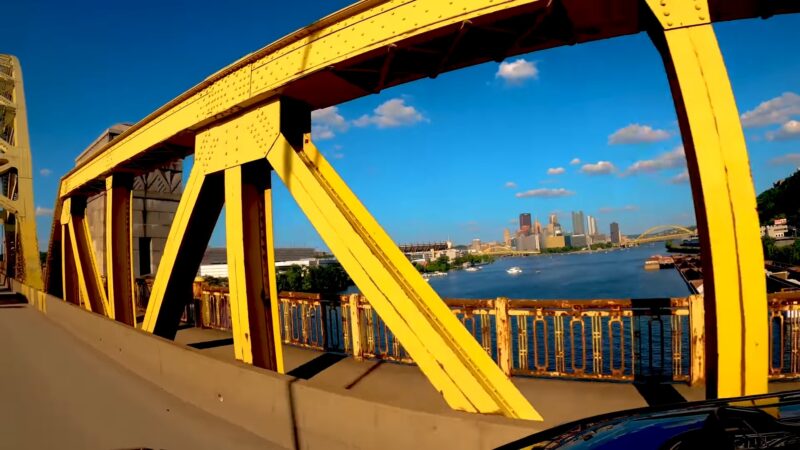
Maintenance is a key factor, as you will certainly agree, but this is not always a straightforward process.
- Preservation Challenges: With age, many of Pittsburgh’s bridges have shown signs of wear and tear. Maintaining these aging giants, especially in the face of harsh weather conditions, has been a challenge for the city’s administration.
- Recent Restorations: Recognizing the historical and functional significance, Pittsburgh has undertaken restoration projects. The rehabilitation of the Liberty Bridge and the renovation of the Greenfield Bridge are notable examples of the city’s commitment to preserving its heritage.
Environmental Considerations
The bridges of Pittsburgh, while historically significant and functionally essential, also intersect with environmental considerations. The rivers they span are vital ecosystems, and the construction and maintenance of bridges have ecological implications.
Over the years, efforts have been made to ensure that bridge construction and renovation projects minimize environmental impact. This includes measures to prevent pollution of the rivers, protect local flora and fauna, and ensure the sustainable sourcing of construction materials.
Symbols of Resilience
Pittsburgh’s bridges are more than just structures of steel and stone; they are symbols of the city’s resilience. They have withstood the test of time, weathered economic downturns, and even faced the brunt of natural disasters. Yet, they stand tall, echoing the indomitable spirit of Pittsburgh and its people.
The bridges have seen the city’s highs and lows, from the booming steel era to the economic challenges that followed. But just like the city, they have adapted, evolved, and continue to serve as vital links in Pittsburgh’s ever-changing landscape.
FAQs
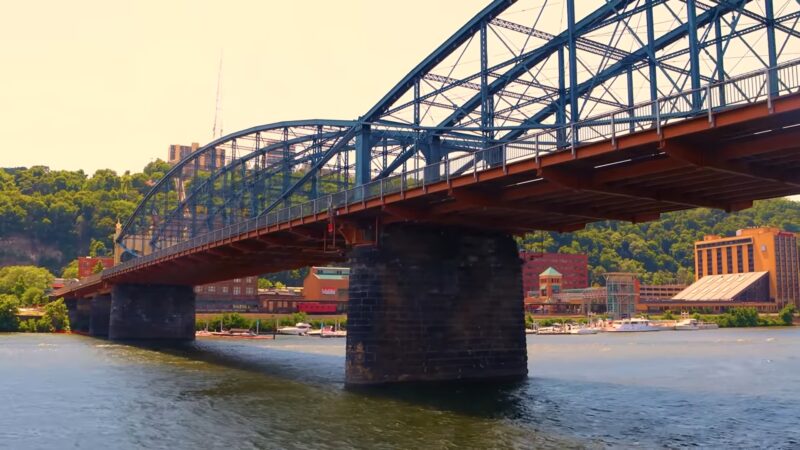
Are All of Pittsburgh’s Bridges Vehicular?
No, while many bridges support vehicular traffic, Pittsburgh also has pedestrian bridges, railway bridges, and mixed-use bridges.
Are There Any Bridge-Related Events or Festivals in Pittsburgh?
Yes, Pittsburgh often celebrates its rich bridge history with events, tours, and festivals, such as the “Bridge Day” where certain bridges are highlighted or closed for festivities.
Why Are Some Bridges in Pittsburgh Painted Golden Yellow?
The golden yellow color is a tribute to the city’s historical ties to the steel industry and its official colors. It also provides a distinctive and unified appearance for many of the city’s bridges.
Can I Take Guided Tours of Pittsburgh’s Bridges?
Yes, several tour operators offer guided tours that highlight the history, architecture, and significance of Pittsburgh’s iconic bridges.
A Wrap-Up
Pittsburgh’s bridges, with their towering arches and sprawling spans, are not just infrastructural marvels but also the heartbeat of a city that has weathered challenges and embraced change. They symbolize the enduring spirit of Pittsburgh, a city that has bridged its storied past with a vision for the future.
As the sun sets over the Allegheny, Monongahela, and Ohio rivers, casting silhouettes of these magnificent structures, one is reminded of the bridges’ timeless allure and their pivotal role in shaping the narrative of the “City of Bridges.”
Discover the culinary delights of Pittsburgh and savor the unique flavors that make this city famous for its food scene.
